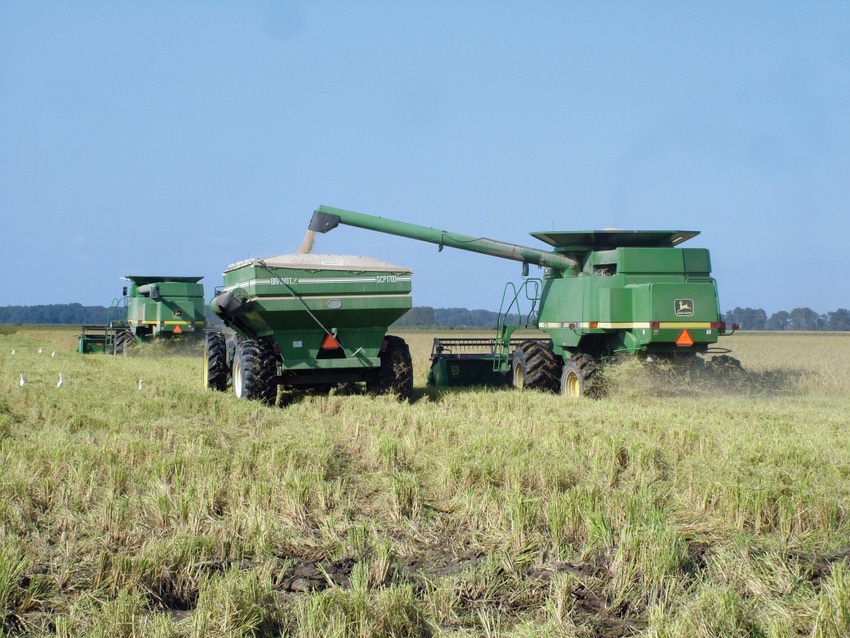January 14, 2013

An LSU AgCenter economist told Vermilion Parish farmers that they have more reasons to be more optimistic this year than they had in 2012.
Kurt Guidry said rice exports have increased in the past few months. Exports of rice are 14 percent above last year, and 91,000 tons of U.S. rice were sold to Colombia recently.
There is anticipation that U.S. rice acreage may drop this year by 100,000 acres with the expectation that Arkansas growers may switch to other crops. “We heard that last year, and it didn’t come to fruition.”
Guidry said it appears that fertilizer prices may remain stable or decline with two new fertilizer plants starting production soon. But he said the projected 99 million acres of corn this year would increase demand for fertilizer.
Diesel prices may be 10-20 cents less than last year.
Mike Salassi, LSU AgCenter economist, said the USDA has projected an average price of $15 per hundredweight, or $24 per barrel, for rice this year.
Also at the series of meetings in Kaplan, Bunkie, Ville Platte, Crowley and Welsh, rice experts from the LSU AgCenter advised farmers of possible strategies to use for the upcoming rice growing season. The LSU AgCenter will hold its final session on Jan. 22 at the Rayville Civic Center for north Louisiana rice farmers.
Steve Linscombe, LSU AgCenter rice breeder and director of the Rice Research Station, said conventional varieties with blast resistance are still available. Catahoula rice had high yields with good blast resistance.
Linscombe said CL151 was more susceptible to blast last year than expected. “If you are going to grow it, plant it as early as possible and plan to use a fungicide.”
Last year’s date-of-planting study showed a benefit to planting in March for most varieties. Linscombe said CL111 had good blast resistance, although it was not immune to the disease.
A Clearfield version of Jazzman is being developed, and foundation seed will be grown at the station this year. Linscombe said the Clearfield Jazzman line has outyielded conventional Jazzman and Jazzman-2 with good blast resistance.
In addition, a medium-grain Clearfield variety is being developed. He said the blast epidemic last year provided a good screening opportunity to eliminate disease-prone lines. “We threw away a lot of things last year we ordinarily would have kept.”
Linscombe said hybrid rice development is progressing at the Rice Research Station.
Caffey, a medium-grain variety, is planned for testing by the Kellogg Co. to determine if it can be used in the company’s cereal products. “Enough of our medium-grain goes to Kellogg that it is pretty important to have it approved by the company.”
Johnny Saichuk, LSU AgCenter rice specialist, said farmers shouldn’t rule out conventional varieties this year. Cheniere, Catahoula and Mermentau varieties remain good choices to grow.
Saichuk advised farmers to start scouting for stinkbugs as soon as rice plants flower. Mowing or rolling the first crop of rice seems to improve grain quality in the second crop.
Eric Webster, LSU AgCenter weed specialist, said using the herbicides RiceBeaux and NewPath increased red rice control by 10-15 percent. The combination also is effective against barnyardgrass.
Webster also detailed a project aimed at controlling dormant hybrid rice and red rice. The best approach is to plant soybeans in an infested field for at least two to three years, but four is best.
Don Groth, LSU AgCenter plant pathologist, said planting early is a good way to reduce problems from blast disease. “The later you plant, the more blast you will have.”
Mike Stout, LSU AgCenter entomologist, said the pesticide Belay is most effective against rice water weevils if applied 24 to 48 hours before a flood. The seed treatment Dermacor has now been approved for water seeding. Stout said this year is the last for the use of methyl parathion for rice stinkbugs.
Dustin Harrell, LSU AgCenter agronomist, said the recommended seeding rate of 60-90 pounds per acre could be reduced to 50-80 pounds. “However, this will vary among varieties.”
You May Also Like




